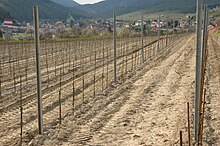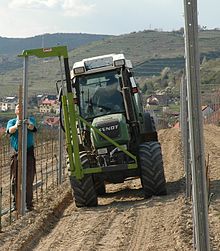Stickel
A Stickel (also Sticher or Stiggel in Austria uprights , pillars or Bagstall ) referred to in viticulture a pile of wood for by the end of the 1950s mostly practiced Stickel education of vines in Stickel Wingert . Even the Romans used stickels in chamber construction for the chamber frame . Upbringing also changed from stick culture to high culture (Wide-area education) and the sticks were used as a support structure for the vines.
technology
The stick is used in the row of vines as a support post , to which the stitching wire , which the climbing plant grapevine needs as support, is attached with staples or wire hooks . At the end of the row, a stronger end post is required, which is anchored in the ground with a rod anchor or other anchoring. Under no circumstances should the tension wire only be attached to a vertical stick, as this can not withstand the tensile forces that occur without losing its stability itself. A distinction is made between middle and end posts (are reinforced).
In the row of vines (row of vines) stickels are required after 5 to 6 vines, so that all wires get a sufficient hold and the supporting structure can carry the weight of all shoots and grapes.
Plant stakes (plant sticks, sticks ) are to be distinguished from stickels , which serve as trunk supports when new vineyards are planted. Today, reinforcement steel or galvanized steel profiles, GRP or spruce sticks are mainly used. Plastic is sometimes used, acacia is rare despite its durability and high stability due to its price, and bamboo is also used in the USA and Asia . These plant sticks have the task of providing support to the trunk, especially in those training systems in which a higher trunk is raised. The vine trunk must be fixed regularly with permanent and elastic binding material, so that the mechanical maintenance work (floor maintenance in the row of trees, trunk cleaning equipment) is not made more difficult by the deformation of the vine trunk.
Piles
Various materials are used for piles (stickels).
Wood
In the past, and sometimes still today, sticks made of wood were used. Different types of wood are used for this , such as acacia , oak , chestnut , beech , fir , spruce or pine . When using wooden sticks, local types of wood should be used. Sustainable and ecological viticulture takes place with sticks made from local wood, as this, as a renewable raw material, has a comparatively favorable environmental balance . Not only is the greenhouse gas carbon dioxide bound in the Stickeln , but they can also be returned to the environmental cycle after decades of use . Stickels made of wood also fit more harmoniously into the landscape . For better durability, wooden posts made of softwoods must be impregnated to protect against wood rot fungi ( wood preservation process ). Hardwood posts do not need to be impregnated, but they are more expensive to buy. Various nails or hooks (galvanized or made of stainless steel ) are hammered into the wood to secure the wires . Steel hooks must be used for hardwood.
metal
They are used with preference today because of their low weight, the simple wire fastening options, the quick and easy installation by machine indentation, their suitability for machine reading and their longevity and low maintenance costs.
The posts are made of galvanized, deformed sheet metal with a specific profile to improve stability or a square or rectangular profile iron. The wall thickness of the metal piles is approx. 1.5 mm. They are strip-galvanized or piece-galvanized for corrosion protection . Galvanized parts, like many metals, are subject to a certain amount of surface metal removal. Locally, there is a higher zinc content in the soil due to the use of galvanized stakes (and wires). But zinc is also a necessary trace element for all plants. The annual withdrawal averages 150 grams of zinc / ha. According to current knowledge, the zinc input does not have a negative effect on the development of the vine.
Recently, metal posts (and also wires) with a corrosion-resistant be zinc aluminum alloy or zinc-magnesium alloy provided. The materials alloyed in this way are significantly more corrosion-resistant and do not rust during the normal service life of a vineyard (30 years on average). An early loss of the galvanization on the wires leads to severe abrasion damage to the green annual shoots of the vines.
The torsional stiffness of the metal posts with a U or C profile is different due to the design. According to the manufacturer intended elasticity (physics) some of the metal piles springs allow and thus avoid the pile for example, that bends in a storm. The elasticity is also advantageous for the mechanical use of grape harvesters . To improve the stability, in particular to improve the resistance to the stronger pressure load caused by cross winds, additional plates (these increase the cross section) in the ground can help. It is important that the driving depth is sufficient and that the distances between the individual piles are not too large.
concrete
Reinforced concrete piles are possible as row or end piles. The tension wires are tied with short pieces of wire (disadvantage: chafing damage), held with special fastening clips or threaded through holes made at the desired height during production. If the concrete cover , quality and workmanship conforms to the (DIN) standards , piles made of reinforced concrete are more durable than those made of other materials.
Widespread in the 1960s to 1980s, concrete piles are rarely used in new systems. On the one hand, this is due to the fact that the construction of the support scaffolding is very complex: the heavy weight makes handling difficult, and mechanical pressing in of the piles is problematic. On the other hand, machine reading is not possible in systems with concrete piles, the vibrating and striking devices of the reading machine would be damaged and the concrete would break.
plastic
For various reasons (high costs, stability is influenced by temperature, UV resistance, etc.), these have not proven themselves. Plastic plant posts are a certain exception.
photos
Control room for birds of prey
swell
- ^ Karl Bauer and colleagues: Viticulture . 8th edition 2008, Österr. Agrarverlag, ISBN 978-3-7040-2284-4 , page 161.
- ↑ Steel refined with zinc-magnesium http://www.as-institute.at/themencenter/themen-a-bis-z/technik-technologie/stahl-zink-magnesium/
literature
- Karl Bauer and colleagues: Viticulture . 8th edition, Austrian. Agrarverlag, Vienna 2008, ISBN 978-3-7040-2284-4 .
- Edgar Müller, Hans-Peter Lipps, Oswald Walg: Viticulture . 3rd edition, Eugen Ulmer, 2008, ISBN 978-3-8001-1241-8 .
- Tim Ochßer: new plant . 1st edition, Meiniger Verlag, Neustadt / Weinstrasse, 2004, ISBN 3-87524-150-9
- Fritz Schuhmann: Weinbau Lexikon , 1st edition, Meiniger Verlag, Neustadt / Weinstrasse, 1998, ISBN 3-87524-131-2
Web links
- Evelyn Hanni and Andreas Andergassen create machine-compatible trellis systems, materials for new systems in viticulture, agricultural and forestry test center Laimburg, Pfatten, South Tyrol (PDF file; 1.25 MB)
- leova vineyard stake
- Metal piles
- Linus Pfahl, DLG test report (PDF file; 991 kB)
- Wire frame design and material overview
- Rolf Fox: LVWO Weinsberg, considerations on vine training and wire frame design
- Oswald Walg: A good support for the vines
- Tierry Wins: "New vine plants and remounting", Agroscope Changins-Wädenswil ACW Research Station, Switzerland 2007
- Fruit and viticulture range, support materials (PDF file; 2.93 MB)









